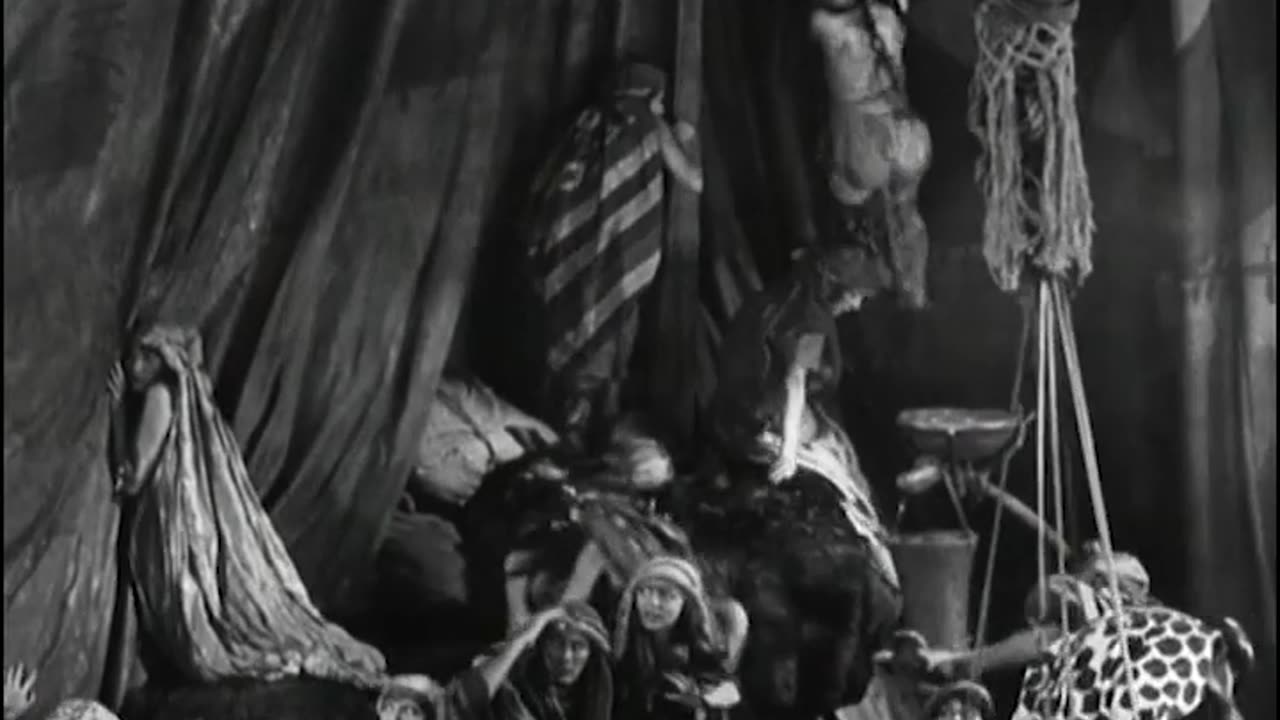Premium Only Content

The Ten Commandments (1923) Full Film
For the 1956 film, also directed by Cecil B. DeMille, see The Ten Commandments (1956 film).
The Ten Commandments
Theatrical release poster
Directed by Cecil B. DeMille
Story by Jeanie MacPherson
Produced by Cecil B. DeMille
Starring
Theodore Roberts
Charles De Roche
Estelle Taylor
Julia Faye
Richard Dix
Rod La Rocque
Leatrice Joy
Nita Naldi
Cinematography
Bert Glennon
Peverel Marley
Archibald Stout
J. F. Westerberg
Edited by Anne Bauchens
Color process Technicolor
Production
company
Famous Players–Lasky Corporation
Distributed by Paramount Pictures
Release dates
December 4, 1923 (Los Angeles premiere)
December 21, 1923 (New York City premiere)
Running time 136 minutes
Country United States
Languages
Silent
English intertitles
Budget $1.5 million[1]
Box office $4.2 million[1][2]
The Ten Commandments is a 1923 American silent religious epic film produced and directed by Cecil B. DeMille. Written by Jeanie MacPherson, the film is divided into two parts: a prologue recreating the biblical story of the Exodus and a modern story concerning two brothers and their respective views of the Ten Commandments.
Lauded for its "immense and stupendous" scenes, use of Technicolor process 2, and parting of the Red Sea sequence,[3] the expensive film proved to be a box-office hit upon release.[4] It is the first in DeMille's biblical trilogy, followed by The King of Kings (1927) and The Sign of the Cross (1932).
The Ten Commandments is one of many works from 1923 that entered the public domain in the United States in 2019.[5]
Plot
Duration: 2 hours, 16 minutes and 13 seconds.2:16:13
The Ten Commandments
The film has two parts: the Prologue, the epic tale of Moses; and the Story, in a modern setting and involving living by the Ten Commandments.
The prologue
The opening statement explains that modern society mocked Judeo-Christian morality until it witnessed the horrors of World War I; it then beseeches the viewer to return to the Commandments, calling them "the fundamental principles without which mankind cannot live together. They are not laws—they are the LAW." From there, the Book of Exodus is recounted, starting just after the ninth plague.
After their flight from Egypt, and the Crossing of the Red Sea, Moses climbs Mount Sinai and witnesses the Commandments given as writing in the sky, which he then carves into stone tablets. When he returns, he finds the Israelites have fallen into debauchery and built a golden calf to worship. Furiously, he smashes the Commandments, deeming the Israelites unworthy. An Israelite man and woman seducing each other find, to the horror of both, that the woman has hideous sores covering her hands and is unclean, prompting her to beg Moses to be cleansed. Moses calls on God's power and lightning destroys the calf.
The story
Two brothers, John and Dan McTavish, live with their mother Martha, a believer in Biblical inerrancy. The two brothers make opposite decisions; John follows his mother's teaching of the Commandments, becoming a carpenter living on meager earnings, and Dan, now an avowed atheist who is convinced the Commandments offer him nothing, vows to break every one of them and rise to the top.
Martha evicts Dan from her house. He stops at a lunch wagon. There, Mary, an impoverished but beautiful young woman, steals a bite of Dan's sandwich, triggering a madcap chase after her. She takes refuge in the McTavish house, where John convinces his mother to take Mary in for the night. John also convinces Dan to set aside his grievance and stay; he introduces Dan to Mary. Dan quickly wins Mary over with his freewheeling ways. Martha's strict observance of the Sabbath causes friction when Dan and Mary dance on Sunday, and, although John tries to convince his mother to show grace, Dan and Mary decide it's time to run off together.
Three years later, Dan has become a corrupt contractor. He earns a contract to build a massive cathedral and decides to cut the amount of cement in the concrete to dangerously low levels, pocketing the money saved and becoming very rich. He puts John, still a bachelor, in charge of construction, hoping to use him to provide her mother the gifts that she refuses to accept from Dan. Dan cheats on Mary with Sally, a Eurasian adulteress. One day, Martha visits John at his work site; a wall collapses on her. Fatally injured, with her last words, she tells Dan she spent too much time trying to teach fear, not love, of God.
Now out of money, Dan learns a muckraker tabloid threatens to expose his operation. His business partner recommends a $25,000 bribe to stop publication, but lacking the funds, Dan instead attempts suicide – his partner stops him, solely because he refuses to take the fall alone, and demands the money. He goes to Sally's brothel to take back expensive pearls he gave her, but Sally refuses, revealing she smuggled herself into the country from Molokai through a contraband jute shipment and is thus infected with leprosy, likely infecting Dan as well. In a rage, he kills Sally and attempts to flee to Mexico on a motorboat (Defiance), but rough weather sends him off course and he crashes into a rocky island. His dead body is among the wreckage. Mary, fearing herself also infected, stops by John's office to say goodbye, but John insists on taking her in. As he reads Mary the New Testament story of Jesus healing the lepers (re-enacted on screen, with Jesus shown only from behind), a light shows Mary's hands not to be scarred at all, and that her perceived scars had disappeared in the light.
Throughout the film, the visual motif of the commandments' tablets appears in the sets, with a particular commandment appearing on them when relevant to the story.
Cast
Prologue
Theodore Roberts as Moses, The Lawgiver
Charles De Roche as Rameses, The Magnificent
Estelle Taylor as Miriam, The Sister of Moses
Julia Faye as The Wife of Pharaoh
Pat Moore (billed as Terrence Moore) as The Son of Pharaoh
James Neill as Aaron, Brother of Moses
Lawson Butt as Dathan, The Discontented
Clarence Burton as The Taskmaster
Noble Johnson as The Bronze Man
Story
Edythe Chapman as Mrs. Martha McTavish
Richard Dix as John McTavish, her son
Rod La Rocque as Dan McTavish, her son
Leatrice Joy as Mary Leigh
Nita Naldi as Sally Lung, a Eurasian
Robert Edeson as Redding, an Inspector
Charles Ogle as The Doctor
Agnes Ayres as The Outcast
Production
The idea for the film was based upon the winning submission to a contest in which the public suggested ideas for DeMille's next film.[2] The winner was F. C. Nelson of Lansing, Michigan; the first line of his suggestion read: "You cannot break the Ten Commandments—they will break you."[2] Production on the film started on May 21, 1923, and ended on August 16, 1923.[2]
Writing
The four main characters of the modern story (from left to right): John McTavish, a carpenter; his mother, Mrs. Martha McTavish; his sister-in-law, Mary Leigh; and his brother, Dan McTavish
Jeanie MacPherson, the film's screenwriter, first thought to "interpret the Commandments in episodic form".[2] Both she and DeMille eventually decided on an unusual two-part screenplay: a biblical prologue and a modern story demonstrating the consequences of breaking the Ten Commandments.[2] In a treatment for the film, MacPherson described the four main characters of the modern story:
There are four people in the modern story of The Ten Commandments, and they view these Commandments in four different ways. There is Mrs. McTavish, the mother, who keeps the Commandments the wrong way. She is narrow. She is bigoted. She is bound with ritual. She is a representative of orthodoxy, yet withal she is a fine, clean, strong woman just like dozens we all know.
There is a girl, Mary Leigh, who doesn't bother about the Ten Commandments at all. She is a good kid, but she has spent so much time working that she hasn't learned the Ten Commandments...
Dan McTavish knows the Ten Commandments, but defies them.
John McTavish is a garden variety of human being, which believes the Ten Commandments as unchanging, immutable laws of the universe. He is not a sissy or a goody-goody, he is a regular fellow, an ideal type of man of high and steadfast principles, who believes the Commandments are as practicable in 1923 as they were in the time of Moses.[2]
Filming
The Gates of Rameses in one of the film's Technicolor sequences
The Exodus scenes were filmed at the Guadalupe-Nipomo Dunes in northern Santa Barbara County.[2] The film location was originally chosen because its immense sand dunes provided a superficial resemblance to the Egyptian desert. Rumor had it that after the filming was complete, the massive sets – which included four 35-foot-tall (11 m) Pharaoh statues, 21 sphinxes, and gates reaching a height of 110 feet, which were built by a small army of 1,600 workers – were dynamited and buried in the sand. Instead, the wind, rain and sand at the Guadalupe-Nipomo Dunes likely collapsed and buried a large part of the set under the ever-shifting dunes. The statues and sphinxes are in roughly the same place they were during filming. In 2012, archaeologists uncovered the head of one of the prop sphinxes; a 2014 recovery effort showed the body of that sphinx to have deteriorated significantly, but a second better-preserved sphinx was discovered and excavated.[6][7] The effort to locate and excavate the set was the subject of a 2016 documentary, The Lost City of Cecil B. DeMille.[8][full citation needed]
The parting of the Red Sea scene was shot in Seal Beach, California.[9] The visual effect of keeping the walls of water apart while the Israelites walked through was accomplished with a slab of Jell-O that was sliced in two and filmed close up as it jiggled. This shot was then combined with live-action footage of Israelites walking into the distance to create the illusion.[10][11]
Portions of the modern story were filmed in San Francisco, with the cathedral building sequence filmed at the then under construction Sts. Peter and Paul Church on Filbert Street and the adjoining Washington Square.
Release
Distributed by Paramount Pictures, The Ten Commandments premiered at Grauman's Egyptian Theatre (in Hollywood) on December 4, 1923.[12][13]
Critical response
Moses leading the Israelites out of Egypt in one of the film's Technicolor sequences
On its release, critics praised The Ten Commandments overall; however, the part of the film set in modern times received mixed reviews.[14] Variety, for example, declared the opening scenes alone worth the admission price, but found the remainder of the film disappointing by comparison: "The opening Biblical scenes of The Ten Commandments are irresistible in their assembly, breadth, color and direction [...] They are immense and stupendous, so big the modern tale after that seems puny."[3]
According to the review aggregator website Rotten Tomatoes, 86% of critics have given the film a positive review based on 7 reviews, with an average rating of 6.7/10.[15]
Box office
The Ten Commandments became the highest-grossing film of 1923. The film's box-office returns held the Paramount revenue record for 25 years until it was broken by other DeMille films.[4] The film competed at the box office with Fox's The Shepherd King, and won out overall.
Ban in China
The movie was banned in the 1930s in China under a category of "superstitious films" due to its religious subject matter involving gods and deities.[16]
Remake
Main article: The Ten Commandments (1956 film)
DeMille directed a second, expanded version of the biblical story in 1956. For the later version, DeMille dropped the modern-day storyline in favor of profiling more of Moses' early life. In 2006, the 1923 film was released on DVD as an extra feature on the 50th Anniversary DVD release of the 1956 film. In the DVD commentary with Katherine Orrison included with the 1923 film, she states that DeMille refilmed several sequences nearly shot-for-shot for the new version, and also had set pieces constructed for the later film that were near-duplicates of what he had used in 1923.[17] On March 29, 2011, Paramount released a new Blu-ray Disc with the 6-disc box set.[18]
https://en.wikipedia.org/wiki/The_Ten_Commandments_(1923_film)
-
 LIVE
LIVE
Bannons War Room
9 hours agoFBI Director Nominee Kash Patel Testifies at Confirmation Hearing
12,633 watching -
 LIVE
LIVE
Benny Johnson
2 hours ago🚨PANIC: Kash Patel FBI Director Confirmation Hearing LIVE Right NOW | Deep State on Life Support
27,779 watching -
 DVR
DVR
Rethinking the Dollar
41 minutes agoThursday Morning Check-In: Trump Plays Blame Game, Fed Pauses and Metals Respond
-
 LIVE
LIVE
Matt Kohrs
10 hours agoMarket Open: New Highs Incoming! (META, NVDA & TSLA) || The MK Show
840 watching -
 LIVE
LIVE
Man in America
2 hours ago🚨 RED ALERT: Did Trump Just BREAK the Bank of England? This Could be HUGE!
704 watching -
 43:25
43:25
BonginoReport
5 hours agoRFK Jr. Goes To War With Big Pharma (Ep.129) - 01/30/2025
61.1K53 -
 1:25:26
1:25:26
Graham Allen
3 hours agoHelicopter CRASHES into plane over DC! + RFK Hearing Gets INTENSE And META To Pay Trump $25M!
37.3K27 -
 DVR
DVR
Randi Hipper
1 hour agoFrom Regulation to Integration: Powell Allows Banks to Embrace Crypto
5.28K -
 LIVE
LIVE
Wendy Bell Radio
6 hours agoBig Pharma B*tches
9,448 watching -
 UPCOMING
UPCOMING
Vigilant News Network
16 hours agoRFK Jr. Stuns Critics: Will He Be Confirmed? | The Daily Dose
25.9K2